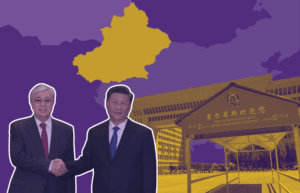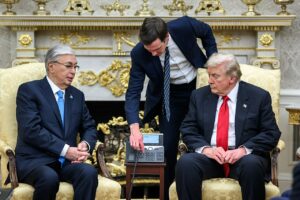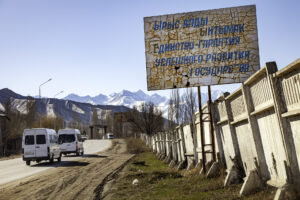In May 2022, anti-government protests erupted in the Autonomous Province of Gorno-Badakhshan. A few days later, the Tajik authorities announced an “anti-terror operation” which, according to a UN report, claimed up to 40 lives. Human rights activists are demanding that those responsible be brought to justice.
On May 14, 2022, residents of Khorog, the capital of the GBAO, held an “unauthorized” rally demanding an end to the persecution of Pamiris who criticized the government. They also called for an investigation into the deaths of several Pamiris in 2021, allegedly involving Tajik police officers. The protesters further demanded the resignation of the mayor of Khorog and the chairman of GBAO. Additionally, they expressed their disagreement with the presence of government military posts in the autonomous region.
At that time, the Tajikistan Prosecutor’s Office claimed that the organizers of the rally were led by Mamadbokir Mamadbokirov, a leader of an “organized criminal group” in Khorog, who allegedly acted on the instructions of the fugitive opposition activist Alim Sherzamonov and independent journalist and human rights defender Ulfatkhonim Mamadshoeva. The authorities accused the organizers of attempting to disrupt public order and influence the government.
Tajikistan’s security forces warned that the organizers’ actions would be considered “terrorism,” and “strict measures would be taken to suppress the rally.” However, the protesters refused to stop the demonstration until their demands were met.
First casualties and escalating tensions
On May 16, the police attempted to disperse the rally, using rubber bullets and tear gas. As a result of the clash, one local was killed, and three police officers got injured. Tajikistan’s authorities accused Zamir Nazrishoev, a resident of Khorog, of being responsible for the incident. According to the police, Nazrishoev “threw a grenade at law enforcement officers, injuring three of them, and was subsequently killed while his armed attack was repelled,” as reported by the ‘Ozodi’ publication, citing the Tajikistan Ministry of Internal Affairs.
On the evening of May 16, all forms of communication were cut off in Khorog, government institutions were temporarily suspended, and military personnel blocked access to the main square.
The following day, the wave of protests shifted to the Rushan district, located 65 kilometers north of Khorog. From May 17 to 18, a group of residents in the Rushan district blocked the entry of military vehicles that were trying to enter from Dushanbe. In response, security forces fired some warning shots, injuring a female.
Main events and the start of the “Anti-Terrorist Operation”
On May 18, the authorities issued a statement accusing the protesters of attempting to undermine Tajikistan’s constitutional order, engaging in provocations with foreign mercenaries, and receiving weapons and financing from “international terrorist organizations.” On the same day, the situation escalated. Gunfire broke out in the district center of Vamar in the Rushan district. At around 7 a.m. Tajik security forces announced the start of the “anti-terrorist operation.”
The Tajikistan government stated that the operation was initiated in response to an attack on a convoy of Tajik security forces and the subsequent blockade of a section of the international road connecting Tajikistan and China. However, according to information published by ‘Ozodi,’ based on residents’ accounts, the protesters pitched barriers to prevent further bloodshed when the military convoy approached Khorog.
Amid a complete lack of reliable information, unverified reports spread on social media. The Telegram channel Pamir Daily News reported snipers positioned along the Pamir Highway firing at residents. The channel also shared information about the use of helicopters.
In the evening of the same day, the Russian news agency ‘TASS,’ citing a source from Tajikistan’s security forces, reported that the “anti-terrorist operation” had ended on May 18. However, the Telegram channel Pamir Daily News published information from a local stating that the “mass cleansing of Rushan and other settlements” was ongoing.
Read more on Novastan: Tajikistan – “ethnic cleansing” and repression in the Tajik Pamirs
“People with weapons were entering houses and indiscriminately detaining all men. The detainees had their phones confiscated en masse, presumably to prevent the publication of evidence of military crimes. There are confirmed cases of looting. Oftentimes, money and gold disappear from houses after a visit by the military. Due to safety concerns, we cannot publish the names of the victims. The situation in Vamar is catastrophic,” quoted Pamir Daily News, citing a local citizen.
On May 22, Mamadbokir Mamadbokirov, the “informal leader” of GBAO, whom the authorities previously identified as one of the instigators of the protests, was killed. According to RIA Novosti, citing the press service of the Tajikistan Ministry of Internal Affairs, he was killed as a result of “internal criminal clashes.” However, according to other information circulating on social media, Mamadbokirov was shot by a sniper from the security services.
Arrests and shootings continued for one month, from May 18, 2022, to June 17, 2022. According to the authorities, the operation resulted in the deaths of 29 people in Rushan and Khorog, including one special service officer. However, according to a UN diplomat report, up to 40 people died during these events.
Arrests of Individuals Accused by Authorities of “Organizing Protests and Violence
On May 18, law enforcement officials arrested human rights defender Ulfatkhonim Mamadshoeva from GBAO, accusing her of organizing the protests. Mamadshoeva, however, denied any involvement in the protests in an interview with the ‘Fergana’ news agency. On December 9, 2022, a Tajik court sentenced Mamadshoeva to 21 years of imprisonment.
Also on the same day, General Kholbash Kholbashev from the State Committee for National Security of Tajikistan was detained. He was charged with assisting a “criminal group” of around 200 individuals who allegedly used weapons to block the Dushanbe-Khorog-Kulma highway on May 17-18. Kholbashev was subsequently sentenced to life imprisonment.
On May 23 and 24, the Ministry of Internal Affairs of Tajikistan published lists containing the names of 46 individuals accused of participating in the protests in Gorno-Badakhshan from May 15 to 18. The government referred to the detainees as “extremists” and accused them of organizing “unlawful rallies, looting, and violence” in the region. The authorities claimed that many of them were members of Kholbash Kholbashev’s alleged “criminal group.”
Reaction of the International Community and Human Rights Defenders
The international community voiced concern over the violence in Gorno-Badakhshan in May and June 2022. UN Secretary-General António Guterres expressed “deep concern” about the situation in Gorno-Badakhshan and called on all parties to “exercise maximum restraint” and “refrain from violence.”
In September 2022, former UN High Commissioner for Human Rights Michelle Bachelet mentioned the crisis in GBAO, expressing concerns about the persecution of local human rights defenders and journalists.
Read more on Novastan: European reaction to repression in Tajikistan has no effect
Ambassadors from several European Union countries called on the Tajikistan government to “take all necessary measures to protect the lives and safety of its citizens” and “ensure the right to peaceful assembly.”
Human Rights Watch demanded that the Tajikistan government “strictly adhere to its obligations to respect and protect human rights to life, freedom of assembly, and freedom of the press during any military or law enforcement operations in the autonomous region of Tajikistan.”
“There was no other way”
On June 18, 2022, Tajikistan’s President Emomali Rahmon spoke about the events in GBAO and expressed support for the actions of the security forces in the region.
According to ‘Ozodi,’ during a meeting with local and republican authorities in the Dangarinsky district on June 18, Emomali Rahmon stated that he had given orders to “neutralize individuals armed with weapons” because, in his words, “there was no other choice.”
Read more on Novastan: In Tajikistan repression continues
“They always claimed to act on behalf of the people of Badakhshan… They never were and are not such… We must clearly understand and approach this problem differently. Personally, this is how I perceive the situation,” President Emomali Rahmon was quoted by the ‘Ozodi’ news agency.
According to critics at Voice of America, Tajikistan’s authorities reject any criticism regarding human rights violations.
“The Tajikistan authorities reject such accusations and state that they respect the rights of all citizens without exception. President Emomali Rahmon, during his working trip to Dangar, in his speech on the events in GBAO, said that ordinary residents of the region are ‘not to blame,” writes Tajikistan expert Sanjar Hamidov in his article.
For the independence of the GBAO or against poverty: what are the Pamiris fighting for?
GBAO is the largest administrative region of Tajikistan, but also the poorest. According to experts, the central government in Dushanbe also ignores the region in addressing its many social problems.
The Pamiris, who constitute the majority of GBAO’s population, differ from other Tajiks in terms of culture and language. They speak various Eastern Iranian languages and are predominantly Ismailis, a branch of Shia Islam. This has led to some disagreements and misunderstandings with the Sunni Muslim majority population in Tajikistan. However, these religious differences are not the main cause of the conflict between the Tajik government and local elites.
Residents of GBAO believe that the central government treats them unfairly. A publication by ‘Azattyk’ shares the statement of a Tajik expert who claims that “all the revenue from the province’s natural resources is controlled by the government, while the region receives only minimal subsidies.”
According to him, the source of anti-government sentiments in the region is the “ill-conceived policies” of the government rather than any desire for greater autonomy or sovereignty. The protesters’ demands in GBAO have a social character and particularly seek to address police brutality. The expert added that the local leaders in the Pamirs prefer not to engage in political opposition.
For more news and analysis from Central Asia, follow us on Twitter, Facebook, Telegram, Linkedin or Instagram.
Written by Cherzod Babakoulov, editor for Novastan
Translated by Tasnim Azimova from French
 Tajikistan: one year since the tragic events in the Pamirs
Tajikistan: one year since the tragic events in the Pamirs 



